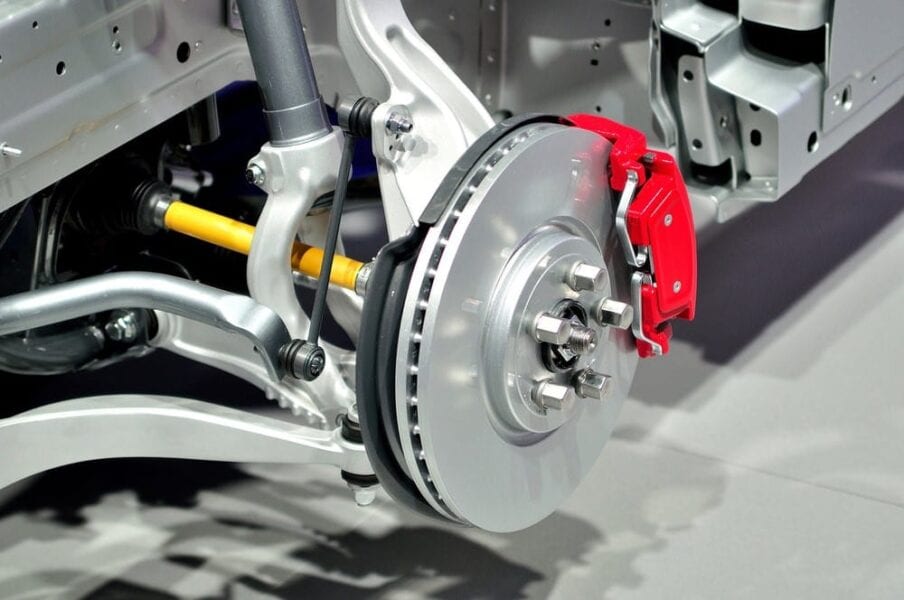
How does a brake caliper work? Device and malfunctions
Content
Brakes came up with cowards! This opinion is shared by fans of extreme driving. But even such drivers actively use the car's braking system. An integral element of modern braking systems is the brake caliper.
What is the principle of operation of this part, its structure, main faults and the sequence of replacement. We will consider all these aspects sequentially.
What is a brake caliper
A brake caliper is a part mounted on the brake disc, which is attached to the steering knuckle or rear beam. The middle class car has front calipers. The rear wheels are equipped with brake drums.
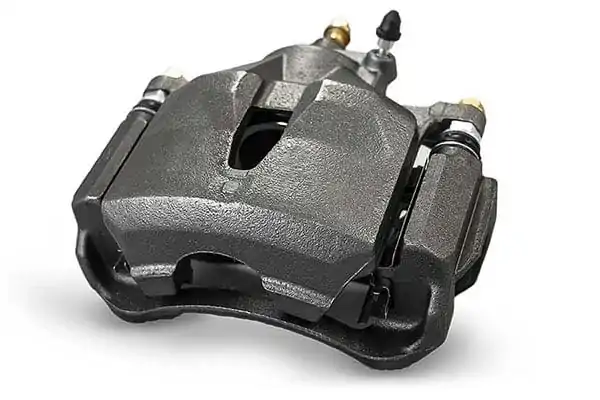
More expensive cars are equipped with full disc brakes, so they also have calipers on the rear wheels.
The action of the brake caliper is directly related to the effort of the driver when he presses the brake pedal while the car is moving. Depending on the force of action on the brake pedal, the response speed will be different. Drum brakes work in a different way, but the braking force also depends on the driver's effort.
Purpose of the brake caliper
As already mentioned, the brake caliper is mounted above the brake disc. When the system is activated, the pads clamp the disc tightly, which helps to stop the hub, and, as a result, the entire car.
This part is collapsible, therefore, if various elements of the mechanism are worn out, you can buy a repair kit and replace the failed spare part.
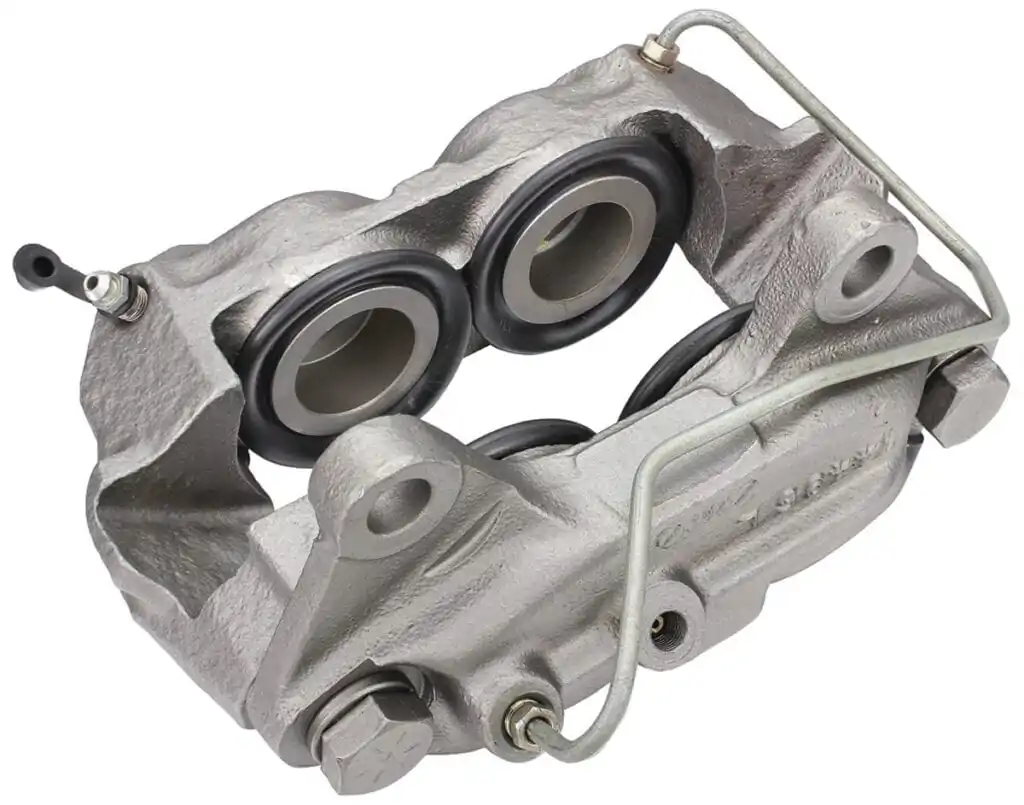
Basically, the brake caliper device includes the following elements:
- Housing;
- Guides on the calipers, which allow you to set the uniform impact of the pads on the disc;
- Piston boot to prevent solid particles from entering the brake actuator so that it does not jam;
- The brake caliper piston, which drives the movable shoe (most often the shoe on the opposite side is attached to the floating caliper and is installed as close to the disc as possible);
- A bracket that prevents the pads from dangling and touching the disc in a free position, causing a grinding noise;
- Caliper spring, which pushes the pad away from the disc when the effort from the brake pedal is released;
- Brake shoe. Basically there are two of them - one on each side of the disc.
How does the brake caliper work?
Regardless of the car model, the braking system in most cases works on a similar principle. When the driver presses the brake pedal, fluid pressure is generated in the brake master cylinder. The forces are transmitted via a highway to the front or rear caliper.
The fluid drives the brake piston. It pushes the pads towards the disc. The rotating disc is pinched and gradually slowed down. During this process, a large amount of heat is generated. For this reason, the car owner needs to pay attention to the quality of the brake pads. Nobody wants to be in a situation where the brakes fail or get jammed.
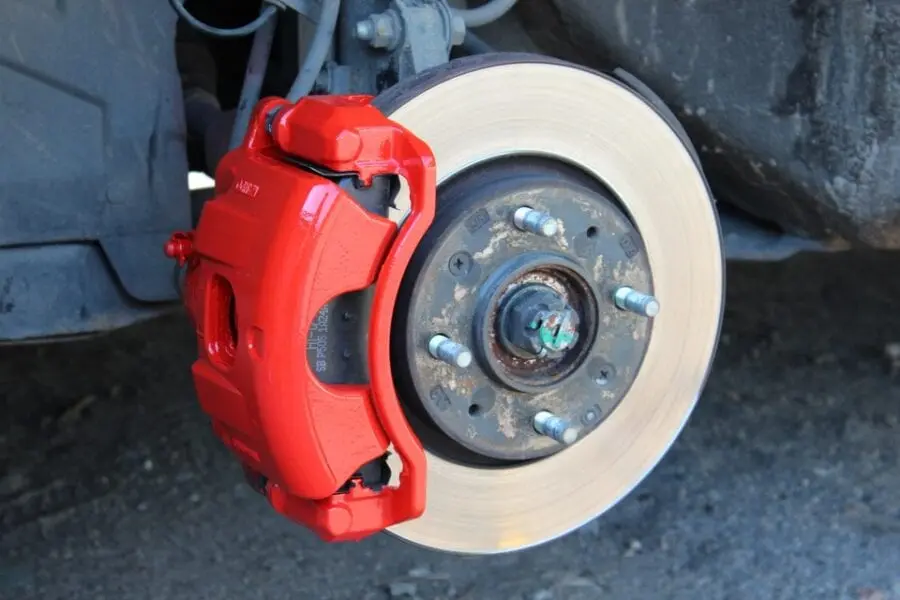
If the car has disc brakes on all wheels, then the rear calipers, as in the drum system, will be connected to the handbrake.
Types of brake calipers
Although today there are many developments aimed at improving the reliability of the braking system, the main ones are two types:
- Fixed brake caliper;
- Floating brake caliper.
Although the design of such mechanisms is different, the principle of operation is almost identical.
Fixed design
These calipers are fixed. They have at least two working pistons. Dual-piston calipers on both sides clamp the disc for increased system efficiency. Basically, these brakes are installed on sports cars.
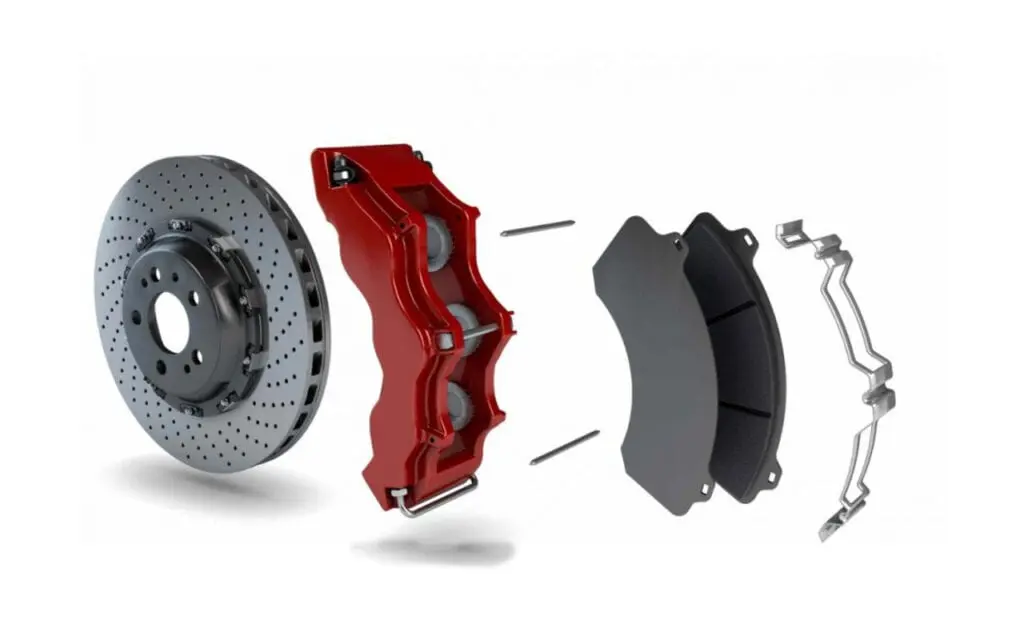
Automotive manufacturers have developed many types of fixed calipers. There are four-, six-, eight- and even twelve-piston modifications.
Floating brake caliper
This type of caliper was created earlier. In the device of such mechanisms there is one piston of the brake cylinder, which drives the shoe, installed behind it on the inner side of the disc.
For the brake disc to be clamped on both sides, there is also a pad on the outside. It is fixedly fixed on a bracket connected to the body of the working piston. When the driver presses the brake pedal, hydraulic force pushes the piston towards the disc. The brake pad rests against the disc.
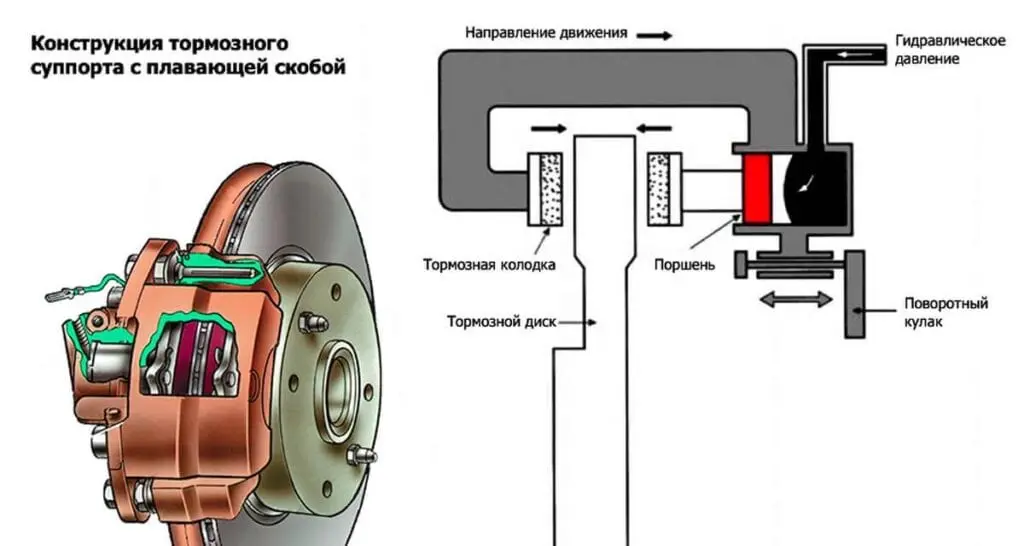
The piston body shifts slightly, driving the floating caliper and pad. This allows the brake disc to be fixed with pads on both sides.
Budget cars are equipped with such a braking system. As in the case of the fixed one, the floating caliper modification is collapsible. They can be used to purchase a repair kit for a caliper and replace a broken part.
Faults and repair of brake calipers
Since the braking system of the car takes on a large load when the vehicle decelerates (in order to increase the service life of the brakes and avoid abnormal situations, experienced drivers use the engine braking method), some parts need to be replaced. But in addition to routine brake maintenance, the system can malfunction.
Here are the common faults, their causes and solutions:
| Problem | Possible manifestations | How to solve |
| Caliper guide wedge (due to wear, dirt or rust, deformation of the caliper) | The car smoothly goes to the side, "grabs" the brakes (braking continues, even when the pedal is released), more effort is required for braking, the brakes jam when the pedal is pressed firmly | Caliper bulkhead, replacement of worn parts. Change anthers. It is possible to clean out elements damaged by corrosion, but if there is a development, then the problem will not be eliminated. |
| Piston wedge (most often due to natural wear or dirt ingress, sometimes due to a worn boot, corrosion forms on the piston surface) | Identical | Some try to grind the piston mirror, however, replacing the part will have more effect. Cleaning will only help with minor corrosion. |
| Breakage of the mounting plate (holds the block in place) | Identical | Replacement at every service |
| Pad wedge or uneven wear | Identical | Check the caliper guide bolt and pistons |
| Leakage of brake fluid through the fitting | Soft pedal | Check where the fluid is leaking, and change the seals or squeeze the hose more tightly on the fitting. |
When repairing a caliper, it is important to choose the correct repair kit that matches the model of the mechanism. Most brake caliper problems are caused by damaged boots, seals and rails.
Depending on the car model and the calipers used in the brake system, the resource of this part can be about 200 thousand kilometers. However, this is a relative figure, as it is primarily influenced by the driver's driving style and the quality of materials.
To repair the caliper, it must be completely removed and cleaned. Further, all channels are cleaned and anthers and seals are changed. The rear caliper connected to the handbrake requires special care. Often, masters at the service station incorrectly assemble the parking system, which accelerates the wear of some of its parts.
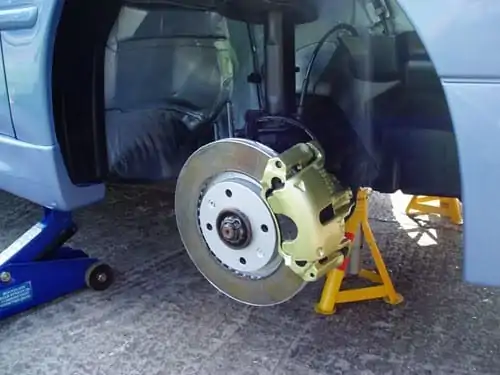
If the caliper is badly damaged by corrosion, there is no point in repairing it. In addition to routine maintenance, attention should be paid to the brake system if the problems listed in the table are observed, as well as if the calipers rattle or knock.
How to choose a brake caliper
It is very important that the caliper is matched to the technical characteristics of the car, namely, to its power. If you install a low-performance version on a powerful car, then at best the brakes will simply wear out quickly.
As for the installation of more efficient calipers on a budget car, this is already a question of the financial capabilities of the car owner.
This device is selected according to the following parameters:
- By car make. All relevant information must be included in the technical documentation. In specialized retail outlets, specialists already have this data, therefore, if the car was purchased on the secondary market without technical documentation, they will tell you which option is suitable for a particular car;
- By VIN-code. This method will allow you to find the original part. However, budget counterparts are selected according to this parameter with no less efficiency. The main thing is that the owners of the resource on which the device is being looked for correctly enter the data;
- Caliper code. To use this method, you yourself need to know this information exactly.
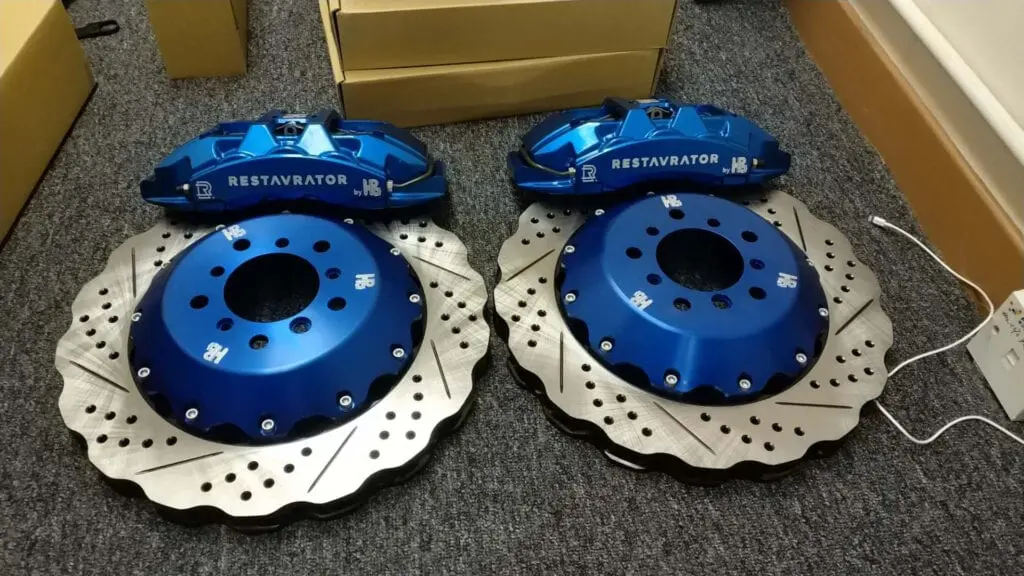
You should not immediately purchase budget counterparts, since some auto parts manufacturers are dishonest about the manufacture of their products. More guarantees - from buying a device from trusted manufacturers such as Meyle, Frenkit, NK, ABS.
Procedure for replacing the brake caliper
It doesn't require any special skills to replace the front or rear caliper. The machine must first be on a level surface. Replacement of a part should always be done as a kit.
The rims are loosened, the car is jacked up (you can start from either side, but in this description, the procedure takes place starting from the driver's side). When the rear mechanism changes, you need to lower the handbrake, put the front-wheel drive car into gear and install chocks under the wheels.
In this case (the caliper is changing from the driver's side), the shoes are installed under the wheels on the passenger side. The machine must not swing forward / backward during work.
The brake system bleed fitting is unscrewed, and the hose is lowered into an empty container. To remove the remaining fluid from the caliper cavity, a clamp is pressed on the piston so that it is hidden in the body.
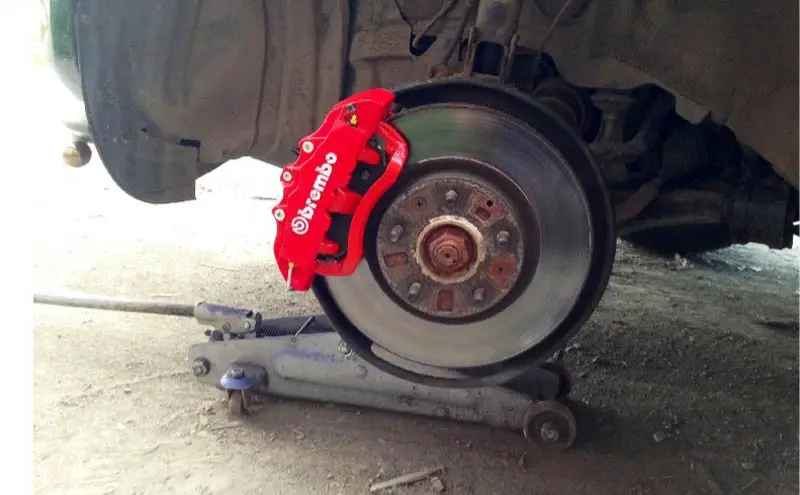
The next step is to unscrew the caliper mounting bolt. In each model, this element has its own location. If the handbrake is raised, the caliper cannot be removed. At this point, the appropriate mechanism for the right side is selected. The brake hose mounting thread must be on top. Otherwise, an incorrectly installed caliper will suck air into the system.
When the caliper changes, you immediately need to pay attention to the discs. If there are irregularities on them, then the surface must be sanded. The new caliper is connected in reverse order.
For the braking system to work properly, you need to bleed the brakes (after replacing all the calipers). Read how to do this in separate article.
Maintenance and repair recommendations
Given that these assemblies are quite expensive, they need periodic care and maintenance. Most often, in the calipers, the guides (floating design) or pistons become acidic. The second problem is a consequence of the untimely replacement of the brake fluid.
If the pistons are not completely acidic, they can be cleaned. As already mentioned, with abundant oxidation (rust), there is no point in repairing the part - it is better to replace it with a new one. It is also worth paying attention to the condition of the spring on the caliper. Due to corrosion, it can lose elasticity or burst altogether.
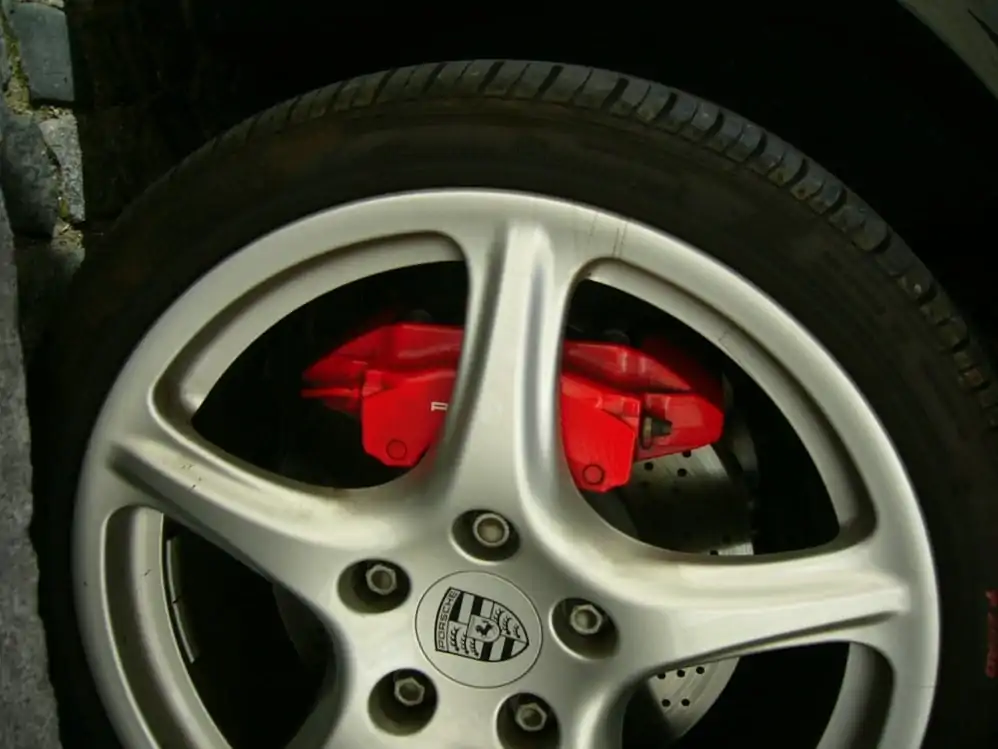
Often paint can protect against corrosion on the caliper. Another plus of this procedure is the aesthetic appearance of the knot.
Dusters, bushings and other sealing materials can be replaced by purchasing a rear caliper repair kit. The front mechanisms are served with the same success.
In addition, watch a video on how brake calipers are serviced:
Questions and answers:
What is a caliper on a car? It is a key element in a vehicle's braking system. It is used in disc braking systems. The mechanism is directly connected to the brake line and brake pads.
What is a caliper for? A key function of the caliper is to act on the pads when you press the brake pedal, so that they press firmly against the brake disc and slow down the rotation of the wheel.
How many pads are in the caliper? The design of the calipers may differ in different car models. Basically, their differences are in the number of pistons, but there are two pads in it (so that the disc is clamped on both sides).

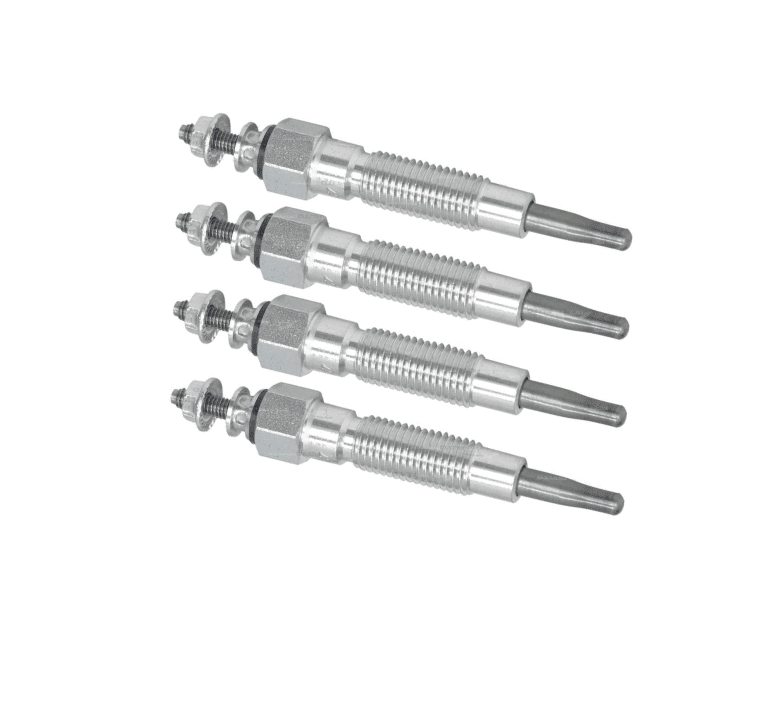
One comment
Gennady
I did not see on the diagram where the piston return spring is located!